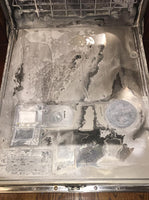If you answered yes, then you’ll want to keep reading. Did you know that the water you use to wash your clothes could be ruining them? Hard water is found in 85% of all homes and businesses in the U.S., that same water goes into the washing machine and causes white fabrics to turn dingy and bright fabrics look faded.

This happens because of the high mineral content in the water. Dissolved calcium and magnesium are the most common minerals found in hard water. When washing clothes in hard water, the minerals bond to fabric, creating a layer of crust that can turn the whitest shirts look yellow. The same effect occurs with colored fabrics, the minerals bond to the fibers and gives the appearance that the colors are faded.
Think of it this way, if you’ve ever baked with flour and have gotten it on your apron, notice how the flour discolored the fabric and made it look ashy? It’s the same concept with hard water, the minerals come into contact with fabric and bonds to it. Over time and multiple washes, the minerals will start to cake on the layers with clothing. Bleaching whites may have little effect since the minerals have formed a shell on the fibers, preventing the bleach from penetrating. At the same time, hard water will leave scale buildup in washing machine drums, and over time, that build up can become abrasive, which will damage fabrics when being washed.
The most effective way to deal with dingy and faded clothing as well as scale buildup is to install a whole house water softener. One of the benefits of a water softener is that it removes the minerals that were mentioned earlier through a process called ion exchange. What that means, water from the mainline of the home will enter a tank and interact with the resin. The small beads in the tank will attract calcium and magnesium from the water and hold on to it while the rest of the water flows through. The resin prevents the minerals from going any further in the system. What ends up in the showers, sinks, dishwasher a washing machine is a water that is devoid of mineral content, also known as soft water. Now that the water is soft, fewer soaps and detergents will be needed to wash clothing. This is because the lack of minerals in the water allows soaps to take up more space, which creates a thicker lather, better cleaning, and leaves whites, white, and colors as bright as the day you bought them.
After a few days, the resin will need to be cleaned or regenerate so it can let go of the minerals that it was holding on to. Next to the tank is a container that is filled with rock salt called a brine tank. During the regeneration process, that tank fills with water and create a salt solution that flows into the resin tank. The saltwater causes the resin beads to release the minerals it had been holding on to, then a backwash is initiated to rid the system of those minerals as well as the saltwater that was used to rinse the resin. Once that’s complete, the resin beads are ready to start grabbing minerals out of the water again.




